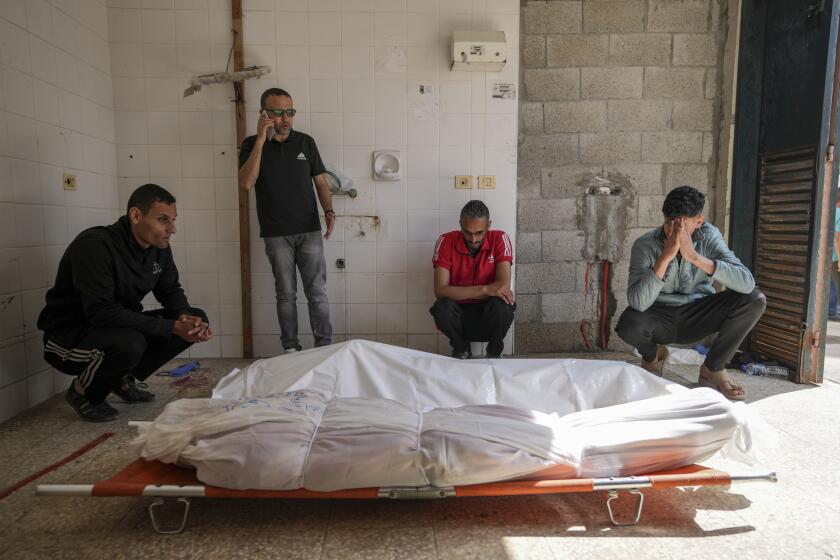NASA Discovers Few American Astronauts Fit Into Russian Space Plan : Cooperation: Several are disqualified from Mir mission because they don’t meet rigid size criteria.
Too tall, too small, too heavy, too chesty--one by one, America’s astronauts are dropping out of the international space scene.
They may have the right stuff, but they’re the wrong size.
In the last month, two NASA astronauts have been disqualified from training for long stays aboard the Russian space station Mir. One was 2 inches too tall, the other 1 1/2 inches too short.
It gets worse. After three years of joint space cooperation, NASA has just learned that only about half of its 88 astronauts can meet rigid Russian size requirements for Soyuz spacecraft, the cramped ships that ferry cosmonauts aloft and also serve as Mir’s emergency escape craft.
Astronauts must be 5 feet 4 1/2 inches to 6 feet tall, with seated height no more than 37 inches; weigh no more than 187 pounds; and, for Soyuz spacesuits, have chests no smaller than 38 inches and no larger than 44 inches.
Of the qualified astronauts, up to two-thirds are training specifically for space shuttle flights and are out of the running for Mir duty. Not all of the remaining 15 or so are eager to move to Russia for the required year of training and then a minimum four months aboard the aging space station.
“Now you take who fits, and who’s available, and who wants to go that’s available, and who can speak Russian and do all this, and the list is very short,” said David Leestma, director of NASA’s flight crew operations.
“It’s clearly a challenge,” he said.
The Soyuz capsules pose a potentially more troublesome problem for the future. When the planned international space station starts taking in permanent residents, perhaps in just 2 1/2 years, the capsules will not only see duty as “lifeboats” but will carry all crews up and back in the first few years of existence.
Translation: NASA may not have enough Russian-speaking, ideally sized astronauts for its desired international space station slots over the next five years.
The Russians have been reluctant, at least so far, to modify the Soyuz to safely accommodate a greater variety of American shapes.
“People are just now beginning to understand the magnitude of the problem,” Leestma said.
Astronaut Norman Thagard, the first American on Mir, was the perfect size--5 feet 9 and 156 pounds, at least when he arrived aboard a Soyuz in March. He lost 17 1/2 pounds in the next four months.
The four other NASA astronauts slated to serve aboard Mir are to arrive and depart via space shuttle Atlantis, but would have to use the attached Soyuz for an emergency getaway.
Because of what NASA claims was miscommunication, NASA only last month got the skinny on the very specific Soyuz size criteria. Their origins are obvious enough: Cosmonauts sit curled in an almost fetal position in the bell-shaped Soyuz capsules, with knees bent toward their chests. The capsules parachute to Earth, typically in Kazakhstan, and the jarring impact can injure an oversized or undersized astronaut’s back--or worse.
The criteria could have come from the early days of the U.S. space program. The original seven astronauts who flew the little Mercury capsules all stood 5 feet 7 to 5 feet 11 and weighed 150-185 pounds.
It’s no wonder Russian cosmonauts still look so much alike.
“Soyuz is Spam-in-the-can, you know,” Leestma said. “It’s Mercury and Gemini all over again. It’s never progressed any further. . . . It works very well for them; it doesn’t do much for tall Americans.”
Or short Americans, hefty Americans, long-waisted Americans, small-chested Americans or barrel-chested Americans.
NASA still has height limits for astronauts, but thanks to the comparatively roomy space shuttles, the range is greater than before--from 4 feet 10 1/2 inches to 6 feet 4.
Astronaut Scott Parazynski, 6 feet 2, was the first to be yanked from the Russian program. He returned to the United States in mid-October after training four months at cosmonaut headquarters outside Moscow. He would have been the fifth and final American to live on Mir, in 1997.
NASA knew he was a little tall but had hoped the Russians would modify a Soyuz for him, said Frank Culbertson, acting director of NASA’s shuttle-Mir program.
The answer? Nyet .
Astronaut Wendy Lawrence, 5 feet 3, was dumped next. She had not yet moved to Russia but was immersed in language study. She would have been the backup to an astronaut who’s scheduled to fly to Mir next year. Her rejection came as a surprise; NASA says it had been given the wrong minimum height.
Having Parazynski and Lawrence disqualified “hurt, but we’re going to recover,” Leestma said. “The long-term problem is the more difficult one, which is the [international] station.”
The Russians are supposed to haul up the first space station component in November, 1997, with cosmonauts and astronauts taking up permanent residence the following spring.
NASA, eager to begin training, hopes the Russians will soon agree to modify the Soyuz by 1998. If not, NASA may have to start recruiting “right-size” astronauts.
More to Read
Start your day right
Sign up for Essential California for news, features and recommendations from the L.A. Times and beyond in your inbox six days a week.
You may occasionally receive promotional content from the Los Angeles Times.






